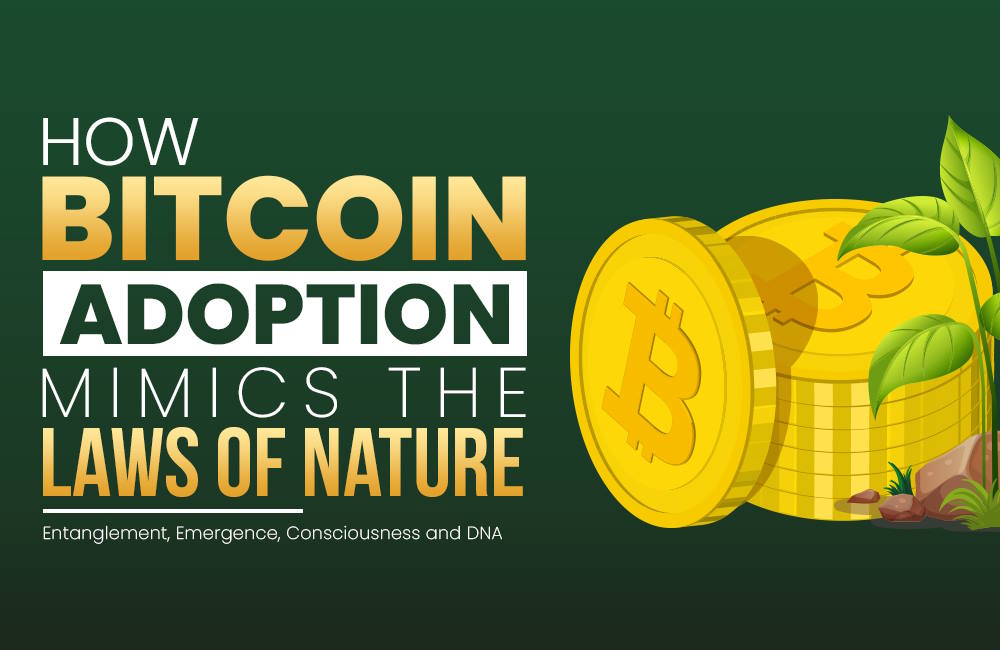
What we're talking about:
How Bitcoin Adoption Mimics the Laws of Nature
As Bitcoin adoption continues to spread throughout the world, it can be intriguing to take a step back and observe how this digital phenomenon is in many ways similar to more natural yet hard-to-grasp concepts. In this article, we’ll take a high-level view of some striking similarities between Bitcoin’s network and advanced theories such as quantum entanglement, emergence, human consciousness and DNA structures.
Follow along as we dive down the rabbit hole.
Bitcoin at the Cross Section of Some Very Deep Concepts
Bitcoin exists on a global, decentralized network. At first glance, it may seem like a straightforward example of a human-designed technical infrastructure. Look a little closer though and you’ll begin to see how this network transcends that of its physical hardware and takes on a life and meaning of its own. This view is comparable to the lens that quantum physicists use to look at our world in its purest form.
As humans, we are barely scratching the surface of what is possible in the deepest depths of the subatomic realm. The more we unravel, the more we discover that the scientific laws that have so long governed our perceptions of reality are in need of rewriting. What we have long taken for granted about space and time is being turned on its head.
The following sections aim to provide brief overviews of these complex topics.
Quantum Entanglement
Entanglement is a phenomenon involving the correlation of two or more particles. This correlation is so intrinsic, it holds true regardless of the distance between the particles. Altering the state of one particle has an instant effect on the other. Einstein famously referred to this as “spooky action at a distance.”
Today, the effect is known more formally as non-locality, and is a defining feature of entanglement. Entanglement plays an important role in many areas of quantum mechanics, including quantum computing and quantum cryptography.
It’s intuitive to draw a parallel here with Bitcoin’s network as its nodes are intrinsically linked though their mirrored copies of Bitcoin’s distributed ledger. The network itself can be considered as a sort of entangled system, where the actions of nodes are interdependent and influenced by the actions of other nodes.
Emergence
Emergence is a term used to describe how small things form together to create bigger things, yet as a whole, have different properties than the sum of their parts. Put differently: how simple things become intelligent together.
Through complex patterns and behaviors, new laws, structures and hierarchies emerge. The emergent properties of a system cannot be explained by the properties of the system’s individual components. Emergence functions at different scales, such as the flocking of birds, the workings of the human brain, or even the security of the Bitcoin blockchain.
The Bitcoin network is much more than the sum of its parts. Through its decentralized system of nodes, each one tasked with a simple set of rules, a complex and secure system for recording and verifying transactions emerges.
Consciousness
Consciousness has been a topic of discussion since the times of ancient Greek philosophers. It wasn’t until the 19th century that the concept garnered more scientific interest, notably through the works of Sigmund Freud and later Carl Jung.
More recent research puts forth the idea that entanglement might have implications for our understanding of consciousness. According to this theory, consciousness could be a fundamental property of the universe that emerges from the quantum entanglement of particles.
While Bitcoin is primarily a technology-driven financial innovation, Bitcoin adoption has broader implications for society. Robert Breedlove and Max Keiser recently discussed a revolution in human consciousness through hyperbitcoinization. The basis for this theory is that the collective unconscious afforded to Bitcoin users through their usage of a decentralized, trustless and immutable network, enables them to live in a society that is intolerant to violence and social injustice.
Keiser touches upon these concepts in his book: The Book of Max: Adventures in a Wildly New World. This collection of essays, anecdotes, and predictions about the future of finance and technology, provides an interesting perspective on the potential of cryptocurrencies and the challenges that they face in achieving mainstream adoption.
DNA
DNA is a critical element of human life as it orchestrates our growth, development and reproduction. The genetic codes held within these double helix molecules contain records of our bloodline’s previous mutations, connecting our bodies today with those of our ancestors. The sequence of information is carefully maintained and replicated during cell division. This ensures that genetic information is passed down accurately from parent to offspring.
In Bitcoin, cryptographic algorithms ensure the security and immutability of all transactions. These records are stored and mirrored across a large network of nodes. According to author Gregg Braden, by storing a distributed record of human genetics, DNA molecules function in a manner similar to how the Bitcoin network timestamps transactions across its tens of thousands of nodes. Gregg sums this analogy up very eloquently in this preview of his masterclass series.
A Word on Quantum Security
We’ve barely scratched the surface here with concepts such as emergence and entanglement, but advances in quantum computing are progressing at a rapid pace. Bitcoin’s network is extremely secure by today’s standards but it remains to be seen how this fares in the era of quantum computing. While quantum computing currently poses no significant threat to Bitcoin, certain experts believe that continuous advances in hardware could possibly lead to Bitcoin’s encryption model being cracked.
Bitcoin’s team of decentralized developers is certainly not going to let such a threat go unchallenged. With advances in quantum computing come other improvements however, such as quantum cryptography. Leveraging these new tools and technology would vastly improve the security of Bitcoin’s network and transactions.
Certain fields of interest include:
- Quantum-resistant signature schemes (such as XMSS)
- Quantum key distribution (QKD)
- Quantum random number generators (QRNG)
- Quantum-resistant consensus algorithms (can PoW withstand quantum mining?)
- Quantum-resistant encryption
One thing’s for sure, in a world where technology evolves at breakneck speeds, an open-source store-of-value network like Bitcoin cannot afford to stay behind when it comes to security and innovation.
Bitcoin: Rewriting the Laws of Finance
Just like advances in quantum mechanics are making us question the very rules of life as we know it, so too is Bitcoin showing us an alternate path for our global financial system. For years we’ve followed the advice of governments and blindly trusted their promise-backed monetary systems. It is in these systems of promises and control by a select few, that we are supposed to store value and transact with trust.
Bitcoin adoption enables society to emerge beyond this flawed promise-based principle by providing a transparent and trustless alternative to the traditional financial system. Its intrinsic value lies in its entanglement of decentralized nodes, immutable ledger, provable scarcity and lightning-fast capabilities. Just as we are rewriting the laws of physics through quantum mechanics, so too are we rewriting the laws of the financial system with fairer, incorruptible technology.
If you’d like to learn more about how Bitcoin adoption is helping humanity, get a head start by reading these articles:
What we're talking about:







